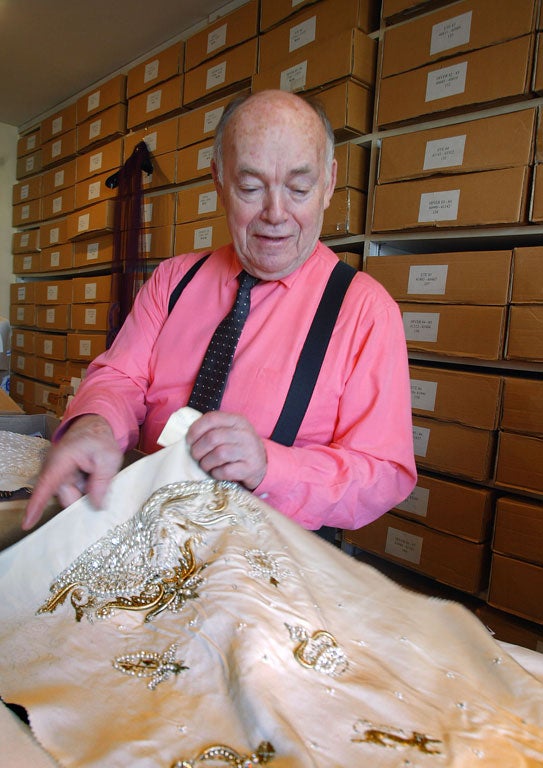François Lesage: Doyen of French haute couture embroidery

The doyen of French embroidery, François Lesage worked with many of the fashion world's élite haute couture designers, including Cristobal Balenciaga, Hubert Givenchy, Coco Chanel and Karl Lagerfeld.
A self-professed bon viveur, who enjoyed the company of his many girlfriends, despite being married, Lesage was synonymous with the highest quality of embroidery. He captured the imagination and outlandish fantasies of his clients, creating pieces such as Yves Saint Laurent's six-figure 1988 "Van Gogh" jackets, John Galliano's thousand-hour embroidered dresses for Christian Dior and Christian Lacroix's most lavish couture fantasies with theatrical spectacles, based on Bizet's Carmen or L'Arlésienne.
"Yves Saint Laurent may call and say, 'I want snakes, crocodiles and alligators,' or Claude Montana may call and say, 'I want sand,'" Lesage said. "Our role is to be chameleons... We receive a sketch and it is up to us to interpret. The couturier is the architect, we are the decorators." Lesage believed that having dealt with and observed fashion designers' egos for decades, he could be an ambassador at the United Nations.
Born on the outskirts of Paris in 1929, Lesage was the son of Albert, an embroiderer, and Marie-Louise Favot, a fashion colourist; he joked that he was "born on a mound of pearls and glitter" and said that it never occurred to him to do anything else. As a baby he was bounced on the knee of the Italiandesigner Elsa Schiaparelli.
A few years earlier his parents had bought the embroidery studio of Albert Michonet, founded during the Second Empire as the embroiderer to Napoleon III. Michonet produced embroideries for Charles Frederick Worth, often considered the founder of couture. At 19, François was sent to Los Angeles to learn English. Welcomed by the French expatriate community, he quickly found his feet and using his father's designs established Lesage-Sunset Boulevard. The business prospered and created pieces for the Hollywood élite including Lana Turner, Eva Gardner and Marlene Dietrich. "Marlene liked figure-hugging dresses," he recalled. "She wanted embroidery that transformed her body into a jewel. It was a pleasure to work for her."
With the death of his father a year later he returned to France to take over Maison Lesage, which had fallen on hard times. Over the next 60 years, Lesage turned the enterprise around and into the best known atelier, though he had to adapt. In America all he had had to do was adapt his father's designs, but in France, things were different: "I had to learn that in business we don't impose anything on the designers. They want to be the origin of everything."
With the rise of ready-to-wear, Lesage expanded production to include embroidery for many American designers, among them Calvin Klein, Bill Blass and Oscar de la Renta.
Throughout his life, Lesage stuck to one golden rule; he refused commissions unless he could meet the client face to face. "I have to see the designer, the sparkle in the eyes," he explained. "I have to undress the mind." He lamented about Alexander McQueen, the only couturier he did not work for. "We had a misunderstanding about one dress," Lesage recalled, "so now, I'm punished!"
Lesage wowed the fashion worldand shows alike with his stunning designs, producing elaborate visions of leaping horses for Schiaparelli and an enormous trompe-l'oeil leopard-skin gown that became a dress by Jean Paul Gaultier. Each work required hundreds, sometimes thousands of hours of precision beadwork to create, commanding prices of more than $100,000 for an elaborate ball gown and more than $60,000 for a jacket.
During the economic downturn of the 1990s, Maison Lesage almost went out of business and was forced to halve its skilled workforce. Lesage had always worried about the dwindling numbers of these artisans, known as "petites mains", and so sought to safeguard the company's future by establishing a school in 1992 near its headquarters in Montmartre, where students are taught the couture techniques and its tradition, from embroidery to flower-, button- and hat-making, with every stitch and every bead or sequin done by hand.
In 2002, Chanel acquired Maison Lesage, which boosted the profile of the embroidery industry and brought it to greater prominence, thanks to the Chanel marketing machine. In recent years Lesage could be spotted at Chanel or Lacroix shows, sharing insights into the craftsmanship with his front-row neighbours.
In 2007, Lesage was made an officer of the Légion d'Honneur, and two weeks ago received the title Maître d'Art from the French Minister of Culture, Frédéric Mitterrand. His work was exhibited from New York to Tokyo.
François Lesage, couture embroidery designer; born Chaville, Hauts-de-Seine, nr Paris 31 March 1929; married (four children); died Versailles 1 December 2011.
Subscribe to Independent Premium to bookmark this article
Want to bookmark your favourite articles and stories to read or reference later? Start your Independent Premium subscription today.

Join our commenting forum
Join thought-provoking conversations, follow other Independent readers and see their replies